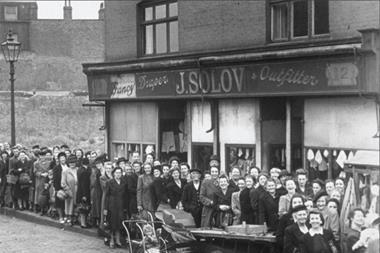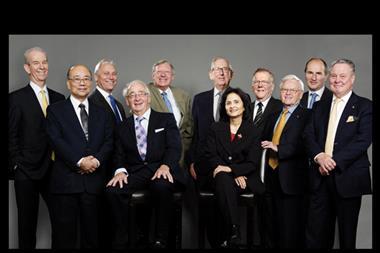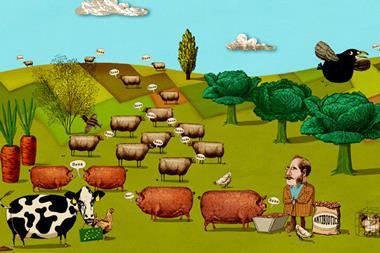What’s behind the enduring success of The Grocer? Adam Leyland charts its evolution, from the confident first issue of this weekly trade circular in 1862 to today’s multimedia operation
It’s easy to forget, as we marvel at the endless versatility of the modern supermarket - offering clothing, music downloads, mobile phones, nail salons, plumbing services and more - that until relatively recently, beer, bread, meat, fish, fruit and even veg were not in the realm of the traditional grocer.
As Patrick Galvani, the godfather of modern supermarkets recalls, in the early 1950s, Alan Sainsbury declared: “Oh my gosh, you’ll never see fresh produce in my stores”. And that was in one of Sainsbury’s newfangled ‘supermarkets’.
So what was it like to be a grocer in 1862? What was The Grocer like? And how has the publication evolved to reflect the utter transformation in the industry?
The first-ever issue of the new trade circular (published as a supplement with the commemorative magazine this week) is instructive in a number of ways. The impressively long and thorough list of products whose prices were quoted included many items that would be unfamiliar to shoppers today: saltpetre (the critical component of gunpowder but also used as a food preservative) bath bricks (an early scouring pad) and numerous whale oil grades - Greenland, South Sea, Sperm (body and headmatter) and Seal (brown and yellow), used predominantly as an illuminant in laps and as candle wax.
The price of exotic produce and provisions from “the Great British Empire” and beyond was also listed in painstaking detail: manna-croup (a form of semolina), melado (a crude liquid sugar mix) and countless types of rice, tea and coffee are here, as well as dried fruit, cocoa, corn, hops, soap, starch and tobacco.
The advertisements are equally revealing. Though the idea of ‘brands’ was still very much in its infancy, suppliers most definitely wore the trousers in those days (and for 102 years to come), announcing their prices in take-it-or-leave-it fashion. Today, of course, this information is a closely guarded secret. And it’s hard to imagine an ad for a ‘Good Shag’ and a ‘Fine Shag’ in 2012 - not least since tobacco advertising was banned in 2002.
Yet while many of the practices and products are of a long-forgotten era (including the purple prose!), the original mission statement of The Grocer remains as true today as it was on 4 January 1862: “To advocate [the grocer’s] interests, advise them on their business operations, and defend them from unjust attacks made upon their fair fame as honest dealers.” “It is high time to come to the rescue of a much-abused trade,” William Reed thundered, “and of an equally abused public, nearly frightened out of their wits through certain organs of the press We shall oppose, to the best of our ability, all indiscriminate onslaughts made on the trade by conceited ignorance incompetent bunglers, malignant enemies or interested motives.”
William Reed also made it abundantly clear, however, that The Grocer would be independent and “at all times strive to counteract the pernicious effects of monopoly”. This was to be no cosy, self-congratulatory or projectionist pamphlet, he promised. “It is not the intention of this journal to throw the shield of its protection over some black sheep in the grocery trade on the contrary, there will be kept a black board whereon to nail them, like noxious bats on barndoors, to the utmost stretch of their wings.”
And this editorial independence was to prove crucial as competition from rival magazines grew. Tony de Angeli, OBE, witnessed at first hand the development of the first supermarket, in a 46-year career at The Grocer. While other trade titles took a hostile stance, The Grocer remained dispassionate.
“We weren’t a paper just for independent grocers. We were a paper for the trade. And we were able to have five feet in five different camps. We reported what the multiples were doing objectively. It was a very clearly balanced attitude. And at this time of great change - with takeovers, constant new innovation, and controversy - we very often got scoops because all the various factions rutted on each other.”
The world in 1862
Politics… Benefit tokens and soup kitchens spring up to feed an increasingly impoverished population as US cotton supply is suspended due to the American Civil War.
International Politics… Otto von Bismarck is appointed the prime minster of Prussia. Despite the abolition of serfdom in 1861, Russians complain over high taxes and inadequate provisions. A new middle class is emerging in India following the creation of the East India Company in 1858.
New companies… Rowntree’s is founded by Henry Isaac Rowntree in York. In Cuba, Facundo Bacardi Masso creates a premium rum filtered through charcoal.
Finance… The national deficit was £3.4m (the 2012 deficit is c. £100bn). A Bliston savings bank collapses after its revered owner steals £8,840.
Sports… Notts County, the oldest professional football club in the world, is formed. In cricket, an England bowler is no-balled for bowling overarm.
Arts… The Russian novelist and playwright Ivan Turgenev coins the term nihilism in Fathers & Sons. Victor Hugo writes Les Miserables.
Innovations… The Gatling gun, the first machine gun, is unvented. The first synthetic plastic is unveiled at the Great Exhibition.
Key grocery innovations… Pasteurisation is discovered. The Aerated Bread Co develops a process for mass-producing bread using CO2.
Another key element of The Grocer’s success, outlined in the very first issue, was its breadth of coverage. William Reed promised “a vast mass of original matter”. “No trouble or expense will be spared on the part of the Proprietor to render the new publication in every way worthy of the patronage of the Grocery Trade,” he noted. The aim was “to place before its readers, in as brief and compendious a form as circumstances will admit the best obtainable information… in a plain, intelligible and convenient form.”
The Grocer retains, 150 years later, one of the biggest editorial teams of any trade media in the country, and continues to break exclusive news every week, while also providing complex, invaluable and often proprietary information in even more plain, intelligible and convenient form.
One area in which The Grocer has been renowned is as a source for prices. As we have seen, from the outset, The Grocer provided pricing information, “furnishing a comparison with the rates at the same date of the previous year to enable grocers to decide on the important question of when, where and how to make their purchases in the way most conducive to their interests”.
As commodity price inflation periodically gripped the market, The Grocer was also to prove incredibly useful in communicating retail price changes. Editor Clive Beddall, OBE, joined in the year the Heath government scrapped retail price maintenance. But The Grocer continued to monitor and publish retail price information, in its “buff list”, as further rampant inflation in the 1970s resulted in constant adjustments in the now ‘recommended retail price’.
“The buff list even appeared in Ronnie Barker’s Open All Hours,” he recalls. “But this information was of enormous interest not only to the trade politicians and shoppers alike lapped up the latest findings. At every general election, we were inundated with calls from MPs seeking food price information for use in their speeches.”
And The Grocer seized on the opportunity to gain wider PR exposure, de Angeli recalls. “We chose very consciously to go for national publicity. We started that early, as prices were running amok. We recorded to the media what was happening. This led to interest from the BBC, who were being bombarded with questions from housewives. So it was a real marriage of convenience. We were, in a way, a spokesman for the manufacturers, but we also had plenty of opinions of our own.”
De Angeli initially appeared on Radio 4 before moving to an hour-long slot on the Jimmy Young Show on Radio 2 for 25 years. He switched to BBC Breakfast in the late 1990s.
Two billion media impressions
This tradition of gaining national exposure for its news and price coverage continues today, with The Grocer receiving over two billion media impressions per year, on average. And that’s not counting the stories where The Grocer isn’t credited. But The Grocer’s coverage of prices and promotions has evolved, over time, to reflect changes in the market, and also opportunities.
The Grocer 33, launched in 1997, pioneered retail price comparison, though with hindsight, the initial service was woefully inadequate, with the 33 items altering every six months! Today, through its joint venture with price comparison website BrandView, The Grocer tracks over 1,000 closely matched items at any one time across the five leading supermarkets. And it also conducts a mystery shop every week to assess service and availability on a nationwide basis.
An all-consuming remit
In an industry now worth over £150bn, it was, to some extent, fortunate that William Reed launched his trade circular for grocers, as opposed to butchers, bakers, brewers or greengrocers, as the remit of the grocer has so all-consumingly widened.
But Reed also recognised, already, the considerable audience for the title. “Though more especially devoted to the interests of the class whose name it bears, The Grocer addresses itself generally to everyone connected with the sale of Groceries in the widest and most extensive application of the term - from the large Colonial Trader, who imports for the use of the great and wealthy the exquisite Pearl and Gunpowder, the fragrant Mocha, the rich fruits of the Orient and the Tropics… down, through many and various gradations of the trade, to the petty Village Chandler who carefully weighs out quarter-ounces of humble Bohea [an inferior grade of tea] to the poor labourer.”
The remit is today even wider of course. As well as myriad global suppliers to the trade, it addresses supermarkets, c-stores, off-licences, forecourts, delis, poundshops, farm shops cash and carry, delivered and foodservice wholesalers not to mention specialist positions that have developed in the trade, in logistics, technology, health, marketing, the environment, public affairs and the City.
The Grocer’s position at the centre of this vast trade was cemented during the Second World War, when it aided the government’s rationing programme. But another key component in its success has been as a melting pot for recruitment advertising. The first issue advertised for ‘Assistants Wanted’, but the high calibre of supplier sales reps reading The Grocer turned the recruitment section into a hunting ground for sales reps from all corners of trade, former MD Laurence Reed recalls. “Ambitious salesmen were ordered to read The Grocer, and the section became a virtuous circle, attracting not only Unilever, but Ford, Black & Decker, ITV and so forth.”
The success of its recruitment section has closely mirrored GDP for many years, peaking in 2001 with 141 pages. Its gradual decline since is partly the result of the economy (it has closely mirrored GDP) but also the encroachment of the internet: as well as jobs boards, many major multiples now advertise only on their own websites.
Industry-leading response rates
But The Grocer has never simply been a hostage to fortune. In addition to awards and conferences, it launched its first jobs website in 1999, The Grocer invested in a state-of-the-art jobs website platform technology called Madjex in 2008, and in 2010 launched its first mobile phone app. And with 80,000 applicants registered for jobs, response rates are industry leading.
The Grocer has also taken up opportunities afforded through technological advancements in printing and desktop publishing. The first issue was produced using quill and ink. But The Grocer always embraced new technology, De Angeli recalls. “A year before Rupert Murdoch provoked the strike at Wapping with his use of new technology, we had introduced the same system without a hitch.”
Reflecting market diversity
In adapting to the new market conditions, The Grocer hasn’t always got it right. By the late 1990s, in a fast-consolidating retail market, it was seen as too supermarket-centric. With weekly news and monthly features sections now dedicated to independents and wholesalers, its remit is again determinedly plural, reflecting market diversity and ensuring, through regular Spotlights and rankings of fast-growth suppliers, that it champions smaller players, and unearths future giants.
The second challenge has been adapting to the internet. On the one hand, it is almost inconceivable to imagine how journalists functioned before the advent of search engines such as Google and it allows the editorial team to communicate with its audience not only daily but instantaneously. On the other hand, this very immediacy, and the low cost of internet publishing, has broken down some barriers to entry, and with journalists regularly flouting copyright laws, exclusive news can be easily turned into a widely circulated commodity.
The Grocer launched its first editorial website in 2001. Development has been considerable. But so has been the market, with social media, smart mobile phones, apps and other technological breakthroughs altering the way our readers demand information. Our work is not done. Which is why, next week, we will announce the next phase in the evolution of The Grocer.
A family affair: ready for the next 150 years
The Grocer is staunchly independent, and not just in its approach to editorial. As part of William Reed Business Media, The Grocer is now run by Charles Reed, the fifth generation of Reed to head the business.
“As we celebrate our first 150 years we remain firmly focused on the future,” says Reed. “We will continue to grow by investing in good people, strong brands and the digital technologies that are transforming forever the way information is delivered and consumed. Our future, like our past, will be shaped by our customers’ needs and powered by evolving technologies.”
In its 150 years, the company has changed dramatically, developing conferences and exhibitions, launching and acquiring numerous awards (including The Grocer Gold Awards and the International Wine Challenge), building industry-leading websites (such as thegrocer.co.uk and Big Hospitality), and acquiring leading titles including Food Manufacture, Restaurant, Harpers and Morning Advertiser.
The purchase of digital specialists Decision News Media in 2009 saw WRBM diversify the business from its core food and drink portfolio to incorporate pharmaceutical and beauty media. The latest acquisition was Him!, a market research company for independent and wholesale grocers. Further launches, joint ventures and acquisitions are promised in 2012 and beyond, adds Reed.



















No comments yet